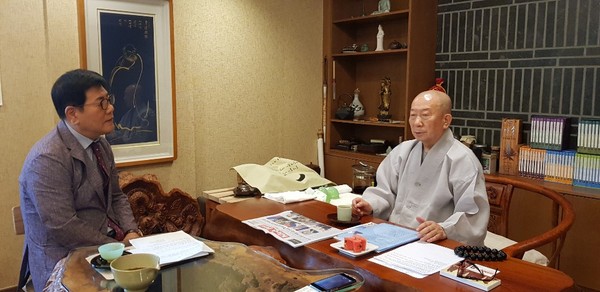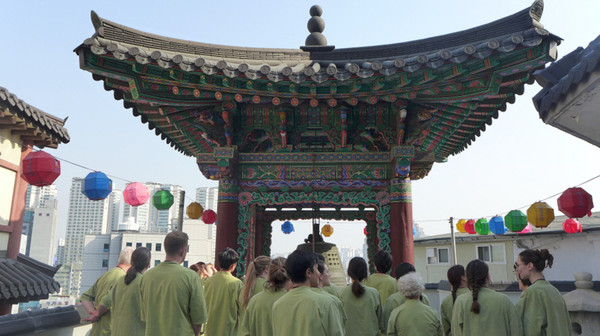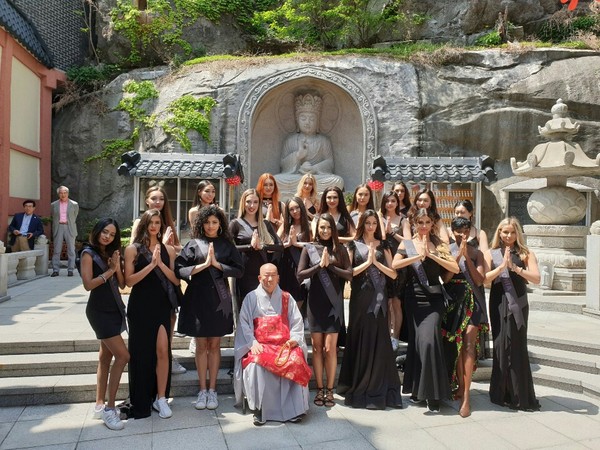tates Chief Abbot Hongpa at an interview with The Korea Post media
By Religious Editor Song Na-ra, Reporter Kim Ka-hee
Ven. Youngsan Hongpa, chief abbot of the Myogak-sa Buddhist Temple in Seungin-dong near the East Gate in Seoul, said, “We are making substantial efforts to promote the Buddhist and cultural exchanges between Korea and many countries of the world, especially with Japan and China.”
At a recent interview with The Korea Post media, publisher of 3 English and 2 Korean-language media outlets since 1985, Ven. Hongpa then said, “We had a special tripartite Buddhist program this year among Korea, China and Japan this year, but we had to postpone it to some other appropriate time due to the continuous spreading COVID-19 contagious disease.
The Korean Buddhist Gwaneum Order, of which Ven. Hongpa is the leader as chief abbot, ranks among the fourth or fifth largest among all Korean Buddhist orders, with the Chogye Order leading the Buddhist world in Korea with a 40 to 50 percent share.

According to Korean news reports, the Myogak-sa is a famous Buddhist temple which was visited by many Presidents of Korea, including President Moon Jae-in, former President Kim Dae-jung, the Prime Ministers, the late Seoul City Mayor Park Won-soon, and various political party leaders.
Having served the Korean Buddhist OA as Secretary General for 31 years, Ven. Hongpa is known to have greatly contributed to the promotion of understanding of Korean Buddhism and Buddhist temples across the country among various international visitors, including Americans, Asians, Europeans, Africans, and peoples from all parts of the world.

How and when did Ven. Hongpa enter Buddhism?
Ven. Hongpa experienced the outbreak of the Korean War (1950-3) at a very young age and realized the meaninglessness of life while young, and finally when he entered the Dongguk University in Seoul, which was a Buddhist institute of advanced education in Korea, after shaving his hair.
In the 1960s, Ven. Hongpa studied and practiced Buddhism in the 1960s as part of the activities of the student Buddhist federation of Korea and also the Buddhist organization at the Ministry of Foreign Affairs of Korea.
Ven. Hongpa also established the Korea-Japan Buddhis Council and also the Korea-China Buddhist Council—greatly contributing to the promotion and enhancement of cooperation among the Buddhist believers of Korea, China and Japan.
Ven. Hongpa also held a memorial and prayer meeting at the U.S. Marine Corps Headquarters in San Diego in the United States for the 50,000 fallen members of the United States Armed Forces in Korea during the Korean War (1950-3), and for this Ven. Hongpa received a Plaque of Appreciation from the then President Bill Clinton
One thing very interesting about the Myogak-sa Buddhist Temple is his organization of ‘Temple Stay’ program for the international visitors to his temple. The program is also open to all the citizens who wish to have peace of mind. Departure from the worldly worries and pains, spiritual rest and recuperation are experienced during the temple stay at his temple.
Ven. Hongpa says, “Through the temple stay program at the Myogak-sa Temple, the visitors, especially the expatriates and casual international visitors can experience peace of the mind as well as the 1,700-year-old Korean Buddhist religion, Buddhist culture and history.

Further details of the Myogak-sa Buddhist Temple of Ven. Hongpa:
Affiliation: Guaneum Order of Korean Buddhism
Location: 31, Jong-ro 63ga-gil, Jongno-gu, Seoul
According to Wikipedia, Myogak-sa houses the administrative headquarters of the Gwaneum Order of Korean Buddhism. It is located close to the Dongmangbong Peak, Naksan Park, Donggwanmyo Shrine and Dongdaemun Market.
Based on a geomantic principle, Mt. Naksan, on which Myogaksa is located, corresponds to a land formation known as “blue dragon on the left” in regards to Seoul, and Myogak-sa stands on the edge of the mountain.
Although Myogak-sa is situated on a rather small piece of land in a residential district, its structural integrity is evident in the layout of such structures as Daebulbojeon, Wontongbojeon, Nakga Seon Center, Seokguram, Mountain God Shrine and an Avalokitesvara image carved into the mountain cliff.
Myogak-sa offers two kinds of Temple Stay programs.

The first option is an overnight program, where participants spend 2 days and 1 night experience life as a Buddhist practitioner. The second program is a daylong cultural program called "Where is your mind?" Depending on age, personal preference, and the time participants would like to spend at the temple, there are a variety of program activities available for everyone.
108 Yeomju (Prayer Beads) Making: Participants experience an opportunity to make prayer beads, during which they will thread 108 beads one by one followed by one prostration for each threading. Experience of Bell-striking: Participants join the temple bell striking ceremony in the quiet and still hours of dawn and evening.
Dado (Tea Ceremony): Participants are able to feel the relaxation of having tea after finishing breakfast. Through a conversation with the monk, participants can have time to talk about their questions or concerns.
Gong-yang (Temple Meal)
Meditation: Body scan meditation and Mindfulness meditation

